Bulbine spongiosa
Bulbine spongiosa Van Jaarsv.
Family: Asphodelaceae
Common names: spongy bulbine (Eng.), sponsblaarkopieva (Afr.)
Introduction
Bulbine spongiosa is an obligatory, summer-deciduous, cliff-hugger from the quarzitic sandstone cliff faces at Badspoort in the Western Cape. Plants have 3 opposite, frail, glaucous, ascending, tapering leaves and a solitary inflorescence bearing yellow flowers in late winter and early spring. Best grown in containers.
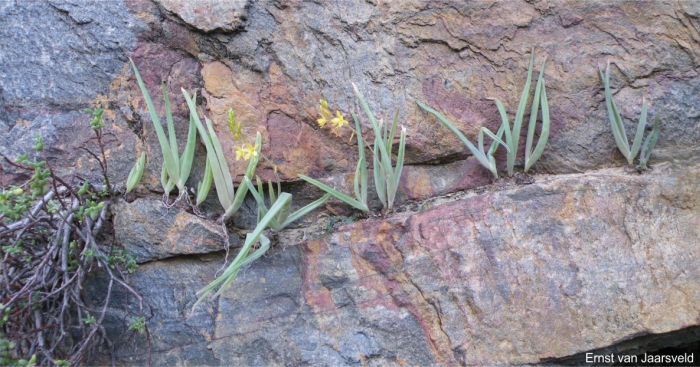
Fig. 1. The spongy bulbine (Bulbine spongiosa) in full flower in the month of August, growing on a cliff ledge on the sheer south-facing cliff at Badspoort, south-east of Calitzdorp, Western Cape, sharing its habitat with a species of Trichodiadema.
Description
Description
Plants summer-deciduous geophytes, at first solitary, the tubers proliferating from the side, filling crevices. The tubers are dark brown conical and 16–22 mm high and 15–18 mm wide at the truncate base. The roots grey-brown, from the perimeter of the tuber, up to 5 mm wide at the base and 50–100 mm long and tapering. The leaf bases are amplexicaul, persistent and weathering leaving a few dry fibres. Leaves erect 2–3 (functional leaves appear in autumn), 90–200 × 5–8 mm ascending, linear-lanceolate, soft textured and faintly translucent, pale grey green obscurely striate, the side flat to channelled, convex or rounded below; surface smooth, wrinkled when withering; margin entire; inner surface (mesophyll) distinctly spongy (bearing cavities); apex acute. The inflorescence grows 135–220 mm long, sparsely flowered, bearing 6–20 flowers in upper quarter; raceme up to 45–70 mm long, the peduncle up to 3 mm diam. at base, biconvex, grey-green. The floral bracts triangular, up to 3 × 0.75 mm, acuminate, clasping. The pedicels 10–15 mm long. The floral perianth is star-shaped (stellate), ± 16–20 mm diam. The floral tepals (2 whorls of three each) pale yellow with greenish yellow median stripes and rounded at the ends (obtuse). The outer tepals narrowly oblanceolate, up to 10 ×4 mm. The inner tepals are elliptic to elliptic-oblanceolate, up to 10 × 4.5 mm. The stamens are up to 5 mm long, bearded in central part, with hairs 1–2 mm long. The ovary obovoid, up to 1.5 mm diameter and the style (female portion) erect, up to 6 mm long. The capsule carrying the seed is obovate, up to 5–7 × 3–4 mm and ascending. The seeds 1.5–2 × 1.5 mm, grey-brown and angular. Flowering occurs in winter and early spring (August to September in the southern hemisphere).
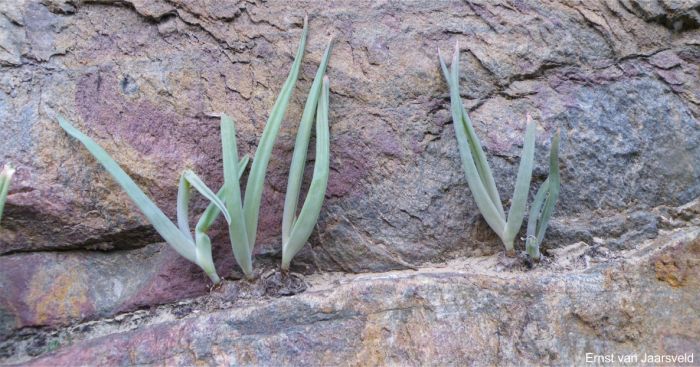
Fig. 2. A close-up of Bulbine spongiosa plants growing in a shallow crevice on the sheer cliff at Badspoort, note the exposed, dark brown tubers.
Conservation Status
Status
The conservation status of Bulbine spongiosa has not yet been assessed by the Red List of South African Plants. Although the population is as yet only known from a single habitat at Badspoort, south of Calitzdorp in the Klein Karoo, the plants grow on sheer cliffs and are thus well protected by its difficult to reach habitat habitat and its distribution falls within a greater conservation region. Consequently it can be regarded as not threatened.
Distribution and habitat
Distribution description
Bulbine spongiosa is known only from Badspoort in the Western Cape, where two rivers join. The Olifanstrivier, which drains large parts of the Klein Karoo, has dissected the local mountains into a deep short gorge just before it joins the Dwyka, which drains most of the Great Karoo. After this junction, it become the Gouritz River. It is at this junction, on sheer sandstone cliffs that are part of the Cape Folded Mountains, where this species and so many cliff-dwellers grow.
The vegetation of Badspoort consists of Gamka Thicket, with Succulent Karoo (Eastern Little Karroo) along the flats and Fynbos (North Rooiberg Sandstone Fynbos) on the upper slopes. Although rainfall may occur at any time of the year, Bulbine spongiosa is a winter grower, becoming dormant during summer. It shares its habitat with evergreen Bulbine species such as B. alooides, B. ramosa and B. frutescens.
The climate at Badspoort is warm temperate and semi-arid, with thunder showers during spring, summer and autumn and cyclonic winter rainfall. The average summer maximum is 26°C and the average minimum is 9.7°C. The average annual rainfall is between 200–300 mm per annum. Bulbine spongiosa occurs on sheer, shady to partially sunny, quartzitic sandstone cliff faces (Cape Supergroup, Witteberg Group). Associated cremnophytes include Albuca thermarum, Crassula badspoortensis, Crassula perforata, Crassula rupestris, Crassula lactea, Crassula orbicularis, Crassula montana subsp. montana, Haworthia floribunda, Haworthia mucronata var. rycroftiana, Ceropegia choanantha (= Tridentea choanantha), Tylecodon leucothrix, Bulbine alooides, Bulbine ramosa and Drimia convallarioides (= Rhadamanthus montanus). Bulbine spongiosa favours crevices and plants proliferate from the base in autumn, forming new tubers. This vegetative crevice invasion eventually transforms its habitat, ensuring less competition.
The geology consists quartzitic sandstone of the Witteberg Group (Cape Supergroup). The substrate has many fissures, ledges and crevices, ideal for establishment of plants.
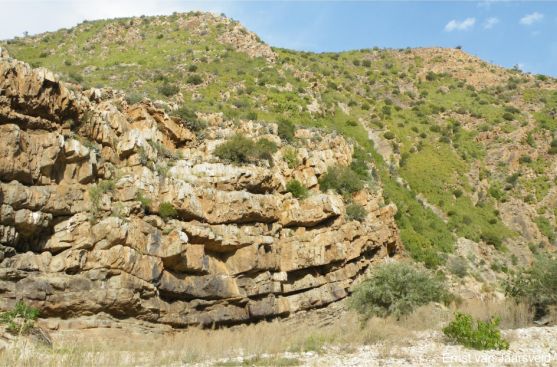
Fig. 3. The exposed Gamka Thicket, cliff habitat of Bulbine spongiosa at Badspoort, south-east of Calitzdorp, note the spekboomveld (Portulacaria afra) in the background.
Derivation of name and historical aspects
History
Bulbine spongiosa was named by the author in the British succulent magazine Bradleya in 2015 from plants collected by Gunther Vandewal, James Deacon and the author in August 2009 (E.v.J 22728) during an expedition to the Western and Eastern Cape. Badspoort was investigated as part of a study investigating cliffs throughout South Africa for obligatory cliff-dwelling succulents (Van Jaarsveld 2011). The name Badspoort pertains to the hot springs (Bad meaning bath, poort meaning gorge) and the nearby resort, Calitzdorp Spa.
Bulbine spongiosa belongs to a group of Bulbine species bearing tuberous roots and ascending and distichous leaves occurring widespread in the winter rainfall region. This is the first cliff dwelling species of Bulbine belonging to this group. The inner texture of the leaves is often spongy, hence the botanical name. This spongy nature has also been observed in B. cepacea. The leaf sap, as in B. ramosa, is not slimy, as it is characteristically found in many other species, and thus is not a good lubricant. Bulbine rupicola also has proliferating tubers, with very different leaves. B. rupicola occurs in the Willowmore district and is a dwarf evergreen species with differently-shaped leaves and flowers. Bulbine ramosa, which is also common on the cliffs, is at once distinguished by its globose tubers and bright green ascending leaves forming dense clusters.
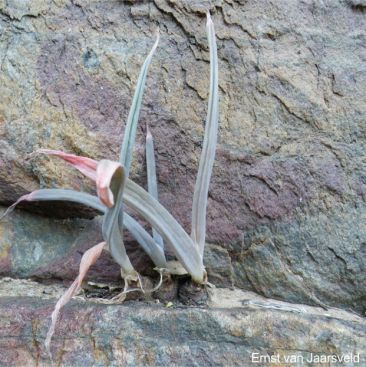
Fig. 4. A struggling plant of Bulbine spongiosa on a ledge of Witteberg quartzite at Badspoort, note the leaves becoming channeled as it slowly dries out.
Ecology
Ecology
Moisture is stored in its succulent tubers enabling the plant to cope during the summer when the plant becomes dormant. Although rainfall can occur at any time of the year, why has Bulbine spongiosa retained its summer dormancy? What is the ecological significance or advantage of summer dormancy? During the winter growing season, moisture can be retained longer in the soil, as temperatures are lower and hence there is less evaporation. The plant can thus use its resources more effectively, becoming dormant during the summers when rainfall is less effective due to the high temperatures. The disadvantage during winter is low temperatures, conditions under which the plants have to grow and flower.
Plants grow in a relatively safe cliff-face environment, free from larger herbivores and also partially protected from fires. The flowers are pollinated by insects and the fruiting capsule ripens during summer, and seed is wind dispersed, usually by updrafts or thermals.
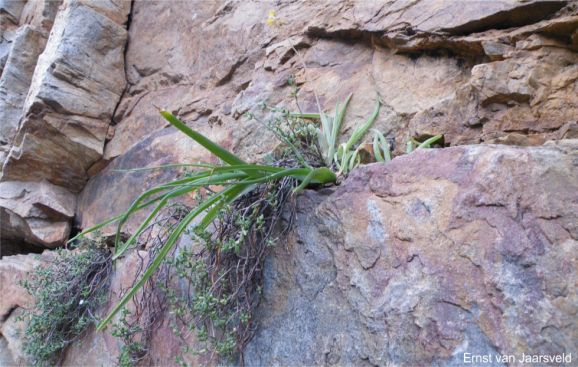
Fig. 5. Bulbine spongiosa in flower, sharing its habitat with Albuca thermarum, at Badspoort.
Uses
Use
No medicinal or cultural uses have been recorded.
Growing Bulbine spongiosa
Grow
Bulbine spongiosa grows well in cultivation. Best cultivated in small containers in well-drained, slightly acidic, sandy, mineral-poor soil – as is found in its natural habitat. They will react to any fertiliser but organic fertilisers such as well-rotted compost is best. As a potted plant, they are best on a balcony or windowsill. When the plants become dormant in spring to early summer, watering should be reduced. Watering can commence again in autumn when plants start to sprout. It is easily propagated by seed or by dividing the tubers. It is a cliff-habitat specialist. The young plants starts solitary, and continue dividing forming small clusters.
Plants at the Babylonstoren Farm Succulent House are grown in hand made clay pots by the artist Ronnie van der Walt.
Divide plants during the summer while they are dormant, and plant in a shallow container and sandy substrate. Rooting should soon take place. Place container in a shady position but with full light.
Sow seed in autumn in a sandy medium. First moisten the substrate with a fine rose. Cover the seed lightly with a thin layer of sand. Keep moist and in a shady position. Germination is usually within 3 weeks and the young seedlings relatively fast growing. Transplant seedlings to individual containers once large enough to handle.
Plants are relatively disease free but slugs and snails can sometimes be a problem.
References
- Mucina, L. & Rutherford, M.C. (eds) 2006. The vegetation of South Africa, Lesotho and Swaziland. Strelitzia 19. South African National Biodiversity Institute, Pretoria.
- Van Jaarsveld, E. J. 2015. Bulbine spongiosa, a new cliff-dwelling species (Asphodelaceae) from the Western Cape. Bradleya 33:156–160.
- Van Jaarsveld, E.J. & Forster, P.I. 2019. Bulbine. In U. Eggli & Nyffeler (Editors) Illustrated handbook of Succulent Plants, Volume 1: 713-738. Monocotyledons (Agavaceae to Asphodelaceae), Second Edition. Springer, Germany.
- Van Jaarsveld, E.J. & Van Wyk, A.E. 2003. Four new cliff-dwelling Bulbine taxa (Asphodelaceae) from the Eastern and Western Cape. Aloe 40(1): 4–7.
- Van Jaarsveld, E.J. 2011. Cremnophilous succulents of southern Africa: diversity, structure and adaptations. Ph.D.Thesis, University of Pretoria.
- Williamson, G. 2000. Four new, succulent Bulbine species (Asphodelaceae) from the Western and Eastern Cape Provinces of the Republic of South Africa. Bradleya 18: 31–40.
Credits
Ernst van Jaarsveld
Kirstenbosch National Botanical Garden (Retired)
Babylonstoren Farm (Current)
Extraordinary senior lecturer and researcher,
Department of Biodiversity and Conservation, University of the Western Cape
November 2025
Plant Attributes:
Plant Type: Succulent
SA Distribution: Western Cape
Soil type: Sandy
Flowering season: Spring, Winter
PH: Acid
Flower colour: Yellow
Aspect: Full Sun, Morning Sun (Semi Shade), Afternoon Sun (Semi Shade)
Gardening skill: Average
Special Features:
Horticultural zones
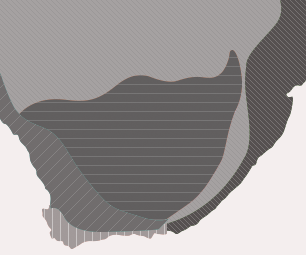






Rate this article
Article well written and informative
Rate this plant
Is this an interesting plant?
Login to add your Comment
Back to topNot registered yet? Click here to register.